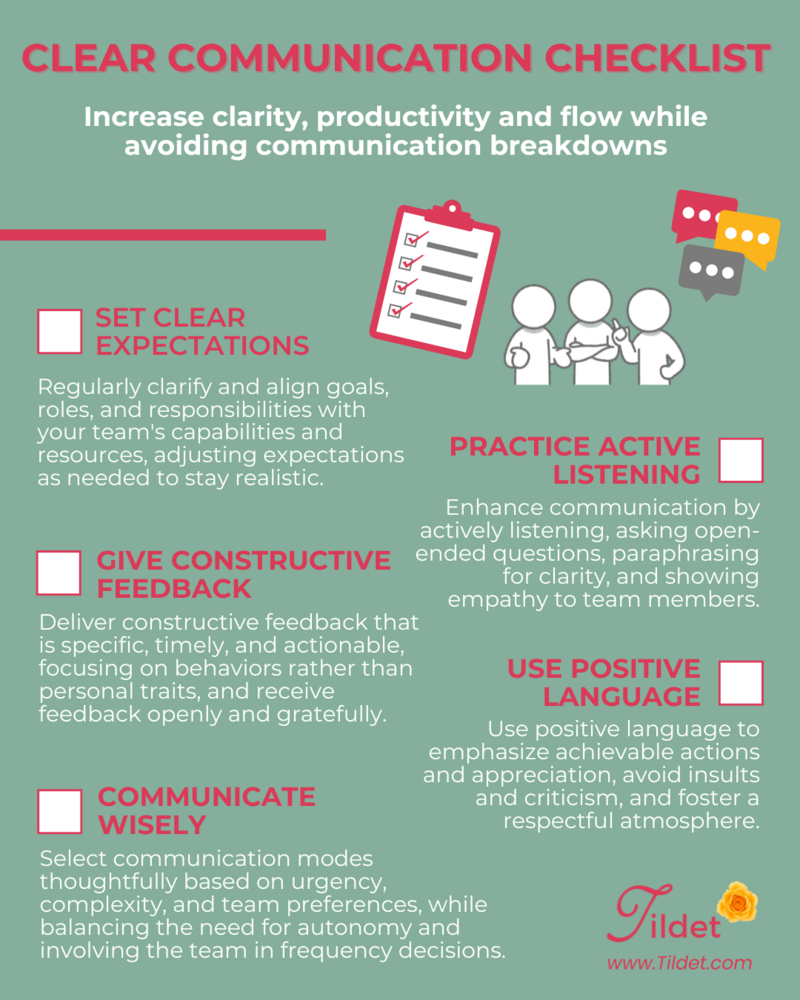When communication breaks down, it creates tension, confusion, and, ultimately, a team that underperforms.
But there’s a simple yet powerful tool to combat this: clear communication. By implementing a few key strategies, you can transform your team’s dynamics.

Setting the Stage for Success: Clear Expectations
Think of expectations as the roadmap for your project. If it’s unclear or outdated, the team might get lost. Here’s how to build a solid roadmap:
- Communicate goals, roles, and responsibilities clearly and regularly. Don’t leave room for guessing.
- Align expectations with reality. Unrealistic deadlines or resource limitations set your team up for failure. Be honest and transparent.
- Be flexible. Things change. Be prepared to adjust expectations as needed to ensure they remain achievable.
Active Listening: The Art of Really Hearing
Communication is a two-way street, and active listening is the key to understanding your team. Here’s how to truly hear and be heard:
- Pay close attention. Put away distractions and focus on what’s being said, both verbally and nonverbally.
- Ask open-ended questions. Don’t just nod and smile. Dig deeper to understand concerns or ideas.
- Paraphrase what you hear. This shows you’re engaged and helps clarify understanding.
- Empathize and support. Let your team members know you care about their struggles and successes.
Constructive Feedback: Your Team’s Growth Engine
Feedback shouldn’t be a dreaded chore, but a tool for growth. Here’s how to give it effectively:
- Keep it specific, timely, and actionable. Focus on specific behaviors and offer suggestions for improvement.
- Focus on the behavior, not the person. Avoid personal attacks or insults.
- Be receptive to feedback as well. Foster a culture of open exchange, where everyone can learn and grow.
The Power of Positive Language
Words matter. Here’s how to use them to create a positive and productive environment:
- Focus on solutions and contributions. Highlight what can be done and what’s appreciated.
- Ditch the negativity. Avoid insults, sarcasm, blame, and criticism.
- Cultivate a culture of respect. Use positive and encouraging language that makes everyone feel valued.
Communication Channels: Choosing the Right Tool
Not all communication methods are created equal. Here’s how to choose wisely:
- Consider urgency, complexity, and preferences. Urgent matters might require a call, while complex topics might benefit from a meeting.
- Strike a balance. Too much communication can be distracting, but too little can lead to confusion.
- Get your team involved. Involve team members in deciding on communication modes and frequency.
By implementing these strategies, you can revolutionize your team’s communication. Clear communication creates less confusion, less tension, and a more supportive environment—that’s the magic of it.
So go forth, bridge communication gaps, and watch your team thrive!
Explore how our Workplace Stress Mastery program can unlock the potential of your team by clicking here!




